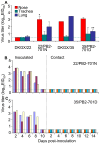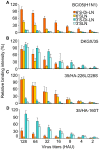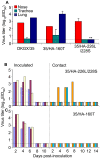Identification of amino acids in HA and PB2 critical for the transmission of H5N1 avian influenza viruses in a mammalian host
- PMID: 20041223
- PMCID: PMC2791199
- DOI: 10.1371/journal.ppat.1000709
Identification of amino acids in HA and PB2 critical for the transmission of H5N1 avian influenza viruses in a mammalian host
Abstract
Since 2003, H5N1 influenza viruses have caused over 400 known cases of human infection with a mortality rate greater than 60%. Most of these cases resulted from direct contact with virus-contaminated poultry or poultry products. Although only limited human-to-human transmission has been reported to date, it is feared that efficient human-to-human transmission of H5N1 viruses has the potential to cause a pandemic of disastrous proportions. The genetic basis for H5N1 viral transmission among humans is largely unknown. In this study, we used guinea pigs as a mammalian model to study the transmission of six different H5N1 avian influenza viruses. We found that two viruses, A/duck/Guangxi/35/2001 (DKGX/35) and A/bar-headed goose/Qinghai/3/2005(BHGQH/05), were transmitted from inoculated animals to naïve contact animals. Our mutagenesis analysis revealed that the amino acid asparagine (Asn) at position 701 in the PB2 protein was a prerequisite for DKGX/35 transmission in guinea pigs. In addition, an amino acid change in the hemagglutinin (HA) protein (Thr160Ala), resulting in the loss of glycosylation at 158-160, was responsible for HA binding to sialylated glycans and was critical for H5N1 virus transmission in guinea pigs. These amino acids changes in PB2 and HA could serve as important molecular markers for assessing the pandemic potential of H5N1 field isolates.
Conflict of interest statement
The authors have declared that no competing interests exist.
Figures








Similar articles
-
H5N1 hybrid viruses bearing 2009/H1N1 virus genes transmit in guinea pigs by respiratory droplet.Science. 2013 Jun 21;340(6139):1459-63. doi: 10.1126/science.1229455. Epub 2013 May 2. Science. 2013. PMID: 23641061
-
A Single-Amino-Acid Substitution at Position 225 in Hemagglutinin Alters the Transmissibility of Eurasian Avian-Like H1N1 Swine Influenza Virus in Guinea Pigs.J Virol. 2017 Oct 13;91(21):e00800-17. doi: 10.1128/JVI.00800-17. Print 2017 Nov 1. J Virol. 2017. PMID: 28814518 Free PMC article.
-
Increased acid stability of the hemagglutinin protein enhances H5N1 influenza virus growth in the upper respiratory tract but is insufficient for transmission in ferrets.J Virol. 2013 Sep;87(17):9911-22. doi: 10.1128/JVI.01175-13. Epub 2013 Jul 3. J Virol. 2013. PMID: 23824818 Free PMC article.
-
The antigenic architecture of the hemagglutinin of influenza H5N1 viruses.Mol Immunol. 2013 Dec;56(4):705-19. doi: 10.1016/j.molimm.2013.07.010. Epub 2013 Aug 7. Mol Immunol. 2013. PMID: 23933511 Review.
-
Challenge for One Health: Co-Circulation of Zoonotic H5N1 and H9N2 Avian Influenza Viruses in Egypt.Viruses. 2018 Mar 9;10(3):121. doi: 10.3390/v10030121. Viruses. 2018. PMID: 29522492 Free PMC article. Review.
Cited by
-
Molecular Characterization of Closely Related H6N2 Avian Influenza Viruses Isolated from Turkey, Egypt, and Uganda.Viruses. 2021 Apr 2;13(4):607. doi: 10.3390/v13040607. Viruses. 2021. PMID: 33918166 Free PMC article.
-
Eurasian-origin gene segments contribute to the transmissibility, aerosol release, and morphology of the 2009 pandemic H1N1 influenza virus.PLoS Pathog. 2011 Dec;7(12):e1002443. doi: 10.1371/journal.ppat.1002443. Epub 2011 Dec 29. PLoS Pathog. 2011. PMID: 22241979 Free PMC article.
-
Glycosylation on hemagglutinin affects the virulence and pathogenicity of pandemic H1N1/2009 influenza A virus in mice.PLoS One. 2013 Apr 24;8(4):e61397. doi: 10.1371/journal.pone.0061397. Print 2013. PLoS One. 2013. PMID: 23637827 Free PMC article.
-
Co-circulation of H5N6, H3N2, H3N8, and Emergence of Novel Reassortant H3N6 in a Local Community in Hunan Province in China.Sci Rep. 2016 May 6;6:25549. doi: 10.1038/srep25549. Sci Rep. 2016. PMID: 27151540 Free PMC article.
-
Egyptian H5N1 influenza viruses-cause for concern?PLoS Pathog. 2012;8(11):e1002932. doi: 10.1371/journal.ppat.1002932. Epub 2012 Nov 15. PLoS Pathog. 2012. PMID: 23166487 Free PMC article. Review. No abstract available.
References
-
- Vong S, Ly S, Van Kerkhove MD, Achenbach J, Holl D, et al. Risk factors associated with subclinical human infection with avian influenza A (H5N1) virus–Cambodia, 2006. J Infect Dis. 2009;199:1744–1752. - PubMed
-
- Claas EC, Osterhaus AD, van Beek R, De Jong JC, Rimmelzwaan GF, et al. Human influenza A H5N1 virus related to a highly pathogenic avian influenza virus. Lancet. 1998;351:472–477. - PubMed
-
- Subbarao K, Klimov A, Katz J, Regnery H, Lim W, et al. Characterization of an avian influenza A (H5N1) virus isolated from a child with a fatal respiratory illness. Science. 1998;279:393–396. - PubMed
Publication types
MeSH terms
Substances
LinkOut - more resources
Full Text Sources
Medical

